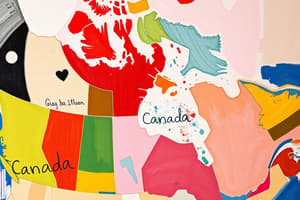Podcast
Questions and Answers
What is the capital of the province of Alberta?
What is the capital of the province of Alberta?
- Edmonton (correct)
- Vancouver
- Winnipeg
- Calgary
Which of the following is NOT a natural resource found in Canada?
Which of the following is NOT a natural resource found in Canada?
- Iron
- Copper
- Diamond (correct)
- Silver
Which climatic region is characterized by harsh, cold winters and short, cool summers?
Which climatic region is characterized by harsh, cold winters and short, cool summers?
- Tropical
- Continental
- Polar (correct)
- Maritime
Which mountain range is found in the province of British Columbia?
Which mountain range is found in the province of British Columbia?
What type of soil is found in the boreal forests of Canada?
What type of soil is found in the boreal forests of Canada?
What is the capital of the province of Nova Scotia?
What is the capital of the province of Nova Scotia?
Which natural resource is NOT a fossil fuel?
Which natural resource is NOT a fossil fuel?
What type of climate is found in the southernmost regions of Canada?
What type of climate is found in the southernmost regions of Canada?
Which mountain range is found in the provinces of Quebec and Newfoundland and Labrador?
Which mountain range is found in the provinces of Quebec and Newfoundland and Labrador?
What type of soil is found in the wetlands of Canada?
What type of soil is found in the wetlands of Canada?
Flashcards are hidden until you start studying
Study Notes
Provincial Capitals
- 10 provinces and 3 territories in Canada
- Provincial capitals:
- Ontario: Toronto
- Quebec: Quebec City
- British Columbia: Victoria
- Alberta: Edmonton
- Saskatchewan: Regina
- Manitoba: Winnipeg
- Nova Scotia: Halifax
- New Brunswick: Fredericton
- Prince Edward Island: Charlottetown
- Newfoundland and Labrador: St. John's
- Territorial capitals:
- Yukon: Whitehorse
- Northwest Territories: Yellowknife
- Nunavut: Iqaluit
Natural Resources
- Canada is rich in natural resources:
- Forests: vast boreal forests, temperate rainforests, and deciduous forests
- Minerals: iron, copper, nickel, gold, silver, and uranium
- Fossil fuels: oil, natural gas, and coal
- Water: abundant freshwater resources, including lakes, rivers, and glaciers
- Fisheries: rich marine fisheries, including salmon, cod, and lobster
Climatic Regions
- Canada has a diverse range of climates:
- Tropical: southernmost regions, such as Vancouver Island and southern Ontario
- Continental: interior regions, such as the Prairies and Quebec
- Polar: Arctic regions, including Yukon, Northwest Territories, and Nunavut
- Maritime: coastal regions, including Nova Scotia, New Brunswick, and Prince Edward Island
- Alpine: mountainous regions, including the Rockies and the Canadian Cordillera
Mountain Ranges
- Canada has several major mountain ranges:
- The Canadian Rockies: includes the Rocky Mountains, Columbia Mountains, and Selkirk Mountains
- The Canadian Cordillera: includes the Coast Mountains, Insular Mountains, and Intermontane Plateaus
- The Appalachian Mountains: includes the Notre Dame Mountains, Long Range Mountains, and Caledonia Highlands
- The Torngat Mountains: located in northern Quebec and Labrador
Soil Regions
- Canada has several distinct soil regions:
- Podzolic soils: found in the boreal forests, characterized by acidic, nutrient-poor soils
- Chernozem soils: found in the Prairies, characterized by rich, fertile soils
- Brown soils: found in the deciduous forests, characterized by well-drained, fertile soils
- Gleysolic soils: found in the wetlands, characterized by acidic, oxygen-poor soils
- Organic soils: found in the peatlands, characterized by high levels of organic matter
Provincial Capitals
- Canada is divided into 10 provinces and 3 territories
- Provincial capitals include Toronto, Quebec City, Victoria, Edmonton, Regina, Winnipeg, Halifax, Fredericton, Charlottetown, and St. John's
- Territorial capitals include Whitehorse, Yellowknife, and Iqaluit
Natural Resources
- Canada is rich in natural resources, including:
- Vast forests (boreal, temperate rainforests, and deciduous)
- Minerals (iron, copper, nickel, gold, silver, and uranium)
- Fossil fuels (oil, natural gas, and coal)
- Abundant freshwater resources (lakes, rivers, and glaciers)
- Rich marine fisheries (salmon, cod, and lobster)
Climatic Regions
- Canada's diverse climate includes:
- Tropical regions (southernmost areas, such as Vancouver Island and southern Ontario)
- Continental climate (interior regions, such as the Prairies and Quebec)
- Polar climate (Arctic regions, including Yukon, Northwest Territories, and Nunavut)
- Maritime climate (coastal regions, including Nova Scotia, New Brunswick, and Prince Edward Island)
- Alpine climate (mountainous regions, including the Rockies and the Canadian Cordillera)
Mountain Ranges
- Canada has several major mountain ranges, including:
- The Canadian Rockies (Rocky Mountains, Columbia Mountains, and Selkirk Mountains)
- The Canadian Cordillera (Coast Mountains, Insular Mountains, and Intermontane Plateaus)
- The Appalachian Mountains (Notre Dame Mountains, Long Range Mountains, and Caledonia Highlands)
- The Torngat Mountains (northern Quebec and Labrador)
Soil Regions
- Canada has several distinct soil regions, including:
- Podzolic soils (acidic, nutrient-poor soils found in boreal forests)
- Chernozem soils (rich, fertile soils found in the Prairies)
- Brown soils (well-drained, fertile soils found in deciduous forests)
- Gleysolic soils (acidic, oxygen-poor soils found in wetlands)
- Organic soils (high levels of organic matter found in peatlands)
Studying That Suits You
Use AI to generate personalized quizzes and flashcards to suit your learning preferences.




